Salar Jung Museum
Coordinates: 17°22′17″N 78°28′49″E / 17.371426°N 78.480347°E
 The Salar Jung Museum building | |
| Location | Dar-ul-Shifa, Hyderabad, Telangana, India |
|---|---|
| Type | Art Museum |
| Key holdings | Veiled Rebecca |
| Collection size | 1.1 million objects |
| Owner | Government of India |
| Website |
www |
The Salar Jung Museum is an art museum located at Dar-ul-Shifa, on the southern bank of the Musi River in the city of Hyderabad, Telangana, India. It is one of the National Museums of India.[1]
It has a collection of sculptures, paintings, carvings, textiles, manuscripts, ceramics, metallic artefacts, carpets, clocks, and furniture from Japan, China, Burma, Nepal, India, Persia, Egypt, Europe, and North America. The museum's collection was sourced from the property of the Salar Jung family, after whom it is named. It is one of the largest museums in the world.
History
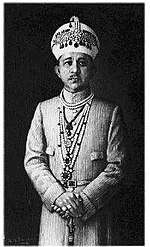
Nawab Mir Yousuf Ali Khan, Salar Jung III (1889–1949) was a nobleman who served as Prime Minister of Hyderabad during the Nizam's rule. He spent a substantial amount of his income, over a period thirty-five years, collecting artifacts from all across the world. After the Nawab died in 1949, the collections were left behind in his ancestral palace Dewan Devdi. The collection was formerly exhibited there as a private museum, named Salar Jung Museum, which was inaugurated by Jawaharlal Nehru on 16 December 1951.[2][3]
Old timers believe that the present collection constitutes only half of the original art wealth collected by Salar Jung III. His employees siphoned off part of it, since Salar Jung depended upon his staff to keep a vigil. Some more art pieces were lost or stolen during the shifting of the museum from Diwan Deodi to the present site.[4]
In 1968, the museum shifted to its present location at Dar-ul-Shifa, and is administered by a Board of Trustees with the Governor of Telangana as ex officio chairperson under the Salar Jung Museum Act of 1961.
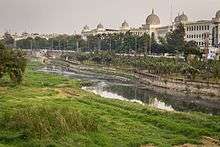
Galleries
The museum building, semicircular in shape with 38 galleries, spread on two floors, displays only a part of the original collection. The ground floor has 20 galleries and the first floor has 18 galleries. The exhibits on different subjects are displayed in separate galleries. Each gallery is huge and has many artifacts on display including ones dating back to the 4th century.
Apart from the galleries, there is a reference Library, reading room, publication and education section, chemical conservation lab, sales counter, cafeteria etc. Guides are available at fixed timings free of charge.[5]
Notable exhibits
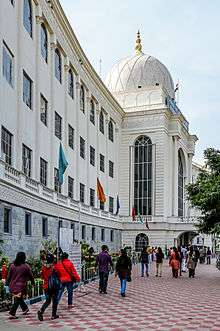
The historical collections includes:[6][7]
- Veiled Rebecca by Giovanni Maria Benzoni,
- The paintings of legendary Raja Ravi Varma,
- Aurangzeb's sword,
- Jade crafted daggers of Emperor Jehangir, Noorjahan and Shah Jahan,
- A wardrobe of Tipu Sultan,
- A tiffin box made of gold and diamond,
- Lady lighting lamp by Abdur Rahman Chughtai,[8]
- Seated Lady by M. F. Hussain,[9]
- Piazza San Marco by Canaletto ,
- Biblis by William-Adolphe Bouguereau,[10]
- Huqqa bottom by Josiah Wedgwood,[11]
The furniture collection includes pieces from the time of King Louis XIV and Napoleon. Salar Jung III collected about 43,000 artifacts and 50,000 books and manuscripts out of which only few are displayed in today's museum.[12]
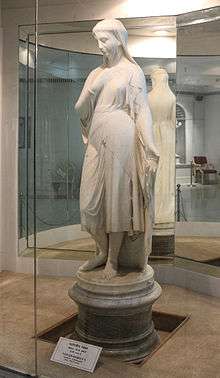
Quran collections
The museum has a famous Quran collection, from around the world in different fonts and designs, called the Quran Written with Gold and Silver. There are many more collections of religious books, as well as Arabic Quran.[13]
Clock
A variety and array of clocks greet the visitor in the clock room. There are ancient sundials in the form of obelisks to huge and modern clocks of the twentieth century. Others in the range vary from miniature clocks which need a magnifying glass to imbibe their beauty and complexity to stately grandfather clocks from as far away as France, Germany, Italy, Switzerland and Britain including the musical clock Salar Jung bought from Cook and Kelvey of England. Every hour, a timekeeper emerges from the upper deck of the clock to strike a gong as many times as it is the hours of the day. The clock is an antique.
The Salar Jung Museum possesses a good number of clocks collected from different European countries such as France, England, Switzerland, Germany, Holland etc. The variety includes the Bird cage clocks, Bracket clocks, Grandfather clocks, Skeleton clocks, etc. The museum is also having some good examples of the clocks of the contemporary period of Louis XV, Louis XVI, and Napoleon 1st of France. The most important clock which attracts the greatest number of visitors everyday is however, a British Bracket clock. It has got a mechanical device by which a miniature toy figure comes out of an enclosure and strikes the gong and then returns to the enclosure at each hour.[14]
The Indian Parliament has declared the museum an Institution of National Importance.
Gallery
 Front view of Salar Jung Museum
Front view of Salar Jung Museum Museum building against cloudy backdrop
Museum building against cloudy backdrop Anantashayana Vishnu: Granite stone, Chola (11th century CE)
Anantashayana Vishnu: Granite stone, Chola (11th century CE)
 Mayur Pankhi in Ivory
Mayur Pankhi in Ivory Arabic calligraphy (from the Quran)
Arabic calligraphy (from the Quran) Eka-Mukha Linga 4th or 5th century CE
Eka-Mukha Linga 4th or 5th century CE
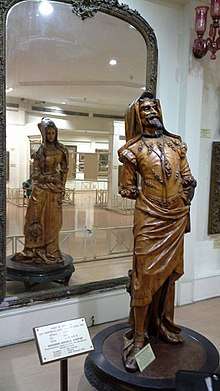 Mephistopheles & Margaretta: Wooden sculpture 19th century CE
Mephistopheles & Margaretta: Wooden sculpture 19th century CE The Veiled Rebecca: melody in marble
The Veiled Rebecca: melody in marble Garuda in Anjali Mudra (18th century CE)
Garuda in Anjali Mudra (18th century CE)
See also
References
- ↑ [Book name: Footprint India By Roma Bradnock, ISBN 978-1-906098-05-6, p-1033]
- ↑ "585 Rani Sarma, Diwan Deodi". www.india-seminar.com. Retrieved 2018-08-06.
- ↑ https://artsandculture.google.com/exhibit/AgJyLZ85CUb4Jw
- ↑ "Old timer's belief".
- ↑ "Galleries". Archived from the original on 15 May 2007.
- ↑ http://www.metrocitytimes.in/magazine/explo-re-the-belum-beau/
- ↑ "important Exhibits".
- ↑ "Lady lighting lamp - Abdur Rahman Chugtai - Google Arts & Culture". Google Cultural Institute. Retrieved 2018-09-26.
- ↑ "Seated lady - M.F. Hussain - Google Arts & Culture". Google Cultural Institute. Retrieved 2018-09-26.
- ↑ "Biblis - William-Adolphe Bouguereau - Google Arts & Culture". Google Cultural Institute. Retrieved 2018-08-06.
- ↑ "Huqqa bottom - Josiah Wedgwood and Sons - Google Arts & Culture". Google Cultural Institute. Retrieved 2018-08-06.
- ↑ "Fire scare at Salar Jung museum". The Times Of India. 2006-11-04.
- ↑ "events". salarjungmuseum.in. 2008. Retrieved 13 April 2012.
- ↑ "Clocks".
External links
| Wikimedia Commons has media related to Salar Jung Museum. |